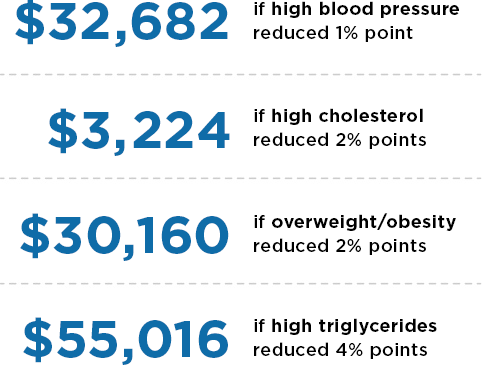The Business Case for Workforce Health
How one school district improved employee health while reducing costs
Oct 1, 2013
Like many organizations, the Redwood Empire Schools’ Insurance Group (RESIG) was facing an unhealthy — and expensive — problem. Approximately 62% of employees in their member districts were overweight or obese, 44% had high or borderline high cholesterol, 15% had high triglyceride levels, and 9% had high blood pressure. Preventable conditions like these not only diminish the quality of life for employees, they’re also responsible for as much as 75% of a company’s total health care costs.*
As health benefits purchaser for employees of the public school districts in Sonoma County, RESIG knew that an effective workforce health program would help to reduce the risk factors affecting their workforce and generate a return on investment. What kind of return? Studies show that companies with effective workforce health programs have lower absenteeism, presenteeism, employee turnover, and workers’ compensation and disability claims costs.†
Annual cost of risk factors per employee
(includes medical expenses and lost productivity)

Kowlessar et al., JOEM, May 2011; Bolnick et al., JOEM, January 2013. Does not include indirect costs.
Designing the program
To reduce the four key risk factors — weight, cholesterol, triglycerides, and blood pressure — we partnered with RESIG leadership to create a data-driven workforce health program that focused on physical activity, healthy eating, weight management, and stress management. Group data from our electronic health record system provided valuable information on the health of employees in RESIG’s member districts. We then implemented a program tailored to the employees’ needs, and over the three-year program period, data showed that many were able to lower their health risks. Rose Burcina, RESIG director of employee benefits, believes the improvement in employee health contributed to the reduction in premium rates RESIG experienced over the same period.
RESIG’s program owes much of its success to the collective efforts of its wellness committee and wellness champions in the member districts. The committee played a hands-on role throughout the entire design and implementation process. Meanwhile, the wellness champions set the bar at their districts by making key decisions, distributing health collateral, spreading the word, and answering employee questions. Here’s an overview of the program’s elements:
- Leadership buy-in — critical for developing a culture of health
- Clinical health data — to target significant cost drivers
- Creation of wellness committee — wellness champions kept program moving
- Goal setting — to define success metrics
- Program implementation — preventive care integrated with educational tools and programs maximized results (most programs available at no charge for Kaiser Permanente members)
- Employee engagement — ongoing communication with workforce helped maintain momentum
- Result tracking — to measure progress

Established a RESIG-led culture of health

Referred to health risks and biometric data

Implemented program featuring:
- total health assessments
- online healthy lifestyle programs
- chronic condition programs
- walking programs
- onsite health education classes
- participation rewards
- onsite flu shot clinics

Integrated medical care program with
workforce health program:
- physicians could recommend online programs and health education classes for specific conditons
- health assessment results linked to electronic health record
- support via kp.org and mobile apps
- health goals supported at office visits

Reported progress through annual biometric reports
Positive results
Over the program’s three-year period, many employees in RESIG’s member districts were able to lower their prevalence rates of obesity/weight gain, elevated cholesterol, high triglycerides, and high blood pressure between 1 to 4 percentage points. This is even more impressive when you consider that the employees also aged over the same period. Typically, the health care costs of employees increase as they get older, so even a small improvement measured against expected national health trends can represent significant cost savings.
RESIG’s successful culture of health means they can better meet the needs of employees in their member districts in future program efforts. And by sharing their ideas, policies, and best practices, they have an opportunity to become a model for other district offices. Through continued focus and support, RESIG expects even more improvement to the health of employees in their member districts and their business.
Potential cost savings per year

For a company of similar size,costs per employee, and improvement rates as RESIG. Estimates based on risk trend mitigation and costs drawn from: Kowlessar et al., JOEM, May 2011; Bolnick et al., JOEM, January 2013. Does not include indirect costs.




